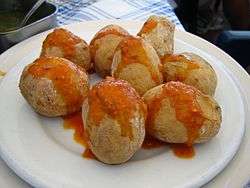Mojo (sauce)


Mojo (Spanish pronunciation: [ˈmoxo], from Portuguese molho [ˈmoʎu], meaning "sauce") is the name, or abbreviated name, of several types of sauces, varying in spiciness, consisting primarily of olive oil, salt, water, local pepper varieties (called pimienta in the Canary Islands), garlic, paprika (called pimentón in Spain), cumin or coriander and other spices. Mojo originated in the Canary Islands, where the main varieties are red mojo (mojo rojo) and green mojo (mojo verde). Other countries have recipes similar to mojo, where acid ingredients such as vinegar, lemon, orange or lime juice may be used.
Canarian mojo
Typology
Green mojo, or mojo containing green spices, is commonly used for fish, specially the proper green mojo (made with green pepper) but also coriander mojo (mojo de cilantro) and parsley mojo (mojo de perejil). As coriander mojo and parsley mojo contain some water, they need to be kept in the fridge and have to be consumed within the two days after preparation.
Red mojo, made of small red peppers from La Palma (called pimienta picona) and paprika, is usually eaten with meat. Red and green mojo can be used interchangeably to season some dishes, prominently papas arrugadas con salsa mojo, or potatoes with mojo. Mojo is also commonly served with fresh bread rolls at the beginning of a meal.
Preparation
To prepare red mojo it is necessary to dry the peppers. Once dry, peppers can be kept for a long time before preparation. Before making mojo, peppers are soaked in water so they lose their spiciness. Then, grains and fibers are removed but for a few that will make the mojo spicy. In the case of green mojo, spiciness will be regulated by the amount of garlic, and can be also intensified by adding ground coriander seeds.
Canarian variations
Local variations of mojo include recipes with cheese such as mojo con queso (mojo with cheese) from La Palma and El Hierro and almogrote from La Gomera, turning it into a paste that can be spread on bread. Every Canarian family has its own recipe for mojo, so it can be very variable in flavour, spiciness and texture. There is also almond mojo which main ingredients are almonds and it is ideal accompaniment to various roasted dishes . Saffron mojo which main ingredient is canarian saffron, it tastes excellent with all kinds of fried cheese. Garlic mojo which main ingredient is garlic and it is ideal to put on pizza. Herb mojo is made of mix spices, it is ideal for salad of any kind.
International variations
Similar sauces, also known as mojo, are also popular in Cuba and throughout the islands of the Caribbean, Hispanic or non-Hispanic, due to heavy Canarian emigration to the Caribbean, and have even influenced some barbecue sauces in the Deep South region of the United States, particularly the states of Florida, Texas, and Louisiana. The flavor can be made of almost everything, from tomato or pepper to avocado.
In Cuban cooking, mojo applies to any sauce that is made with garlic, olive oil, and a citrus juice, traditionally bitter orange juice. It is commonly used to flavor the cassava tuber and is also used to marinate roast pork.[1] Without oregano, the sauce is typically called 'mojito' and used for dipping plantain chips and fried cassava (yuca). To create the marinade for pork, the ingredients are bitter orange juice, garlic, oregano, and salt.
In Puerto Rico, mojo is a herb sauce of finely chopped coriander or parsley with salt, plenty of crushed garlic and olive oil. Black pepper, butter, grated onion, vinegar and any citrus fruit can also be added. It is commonly used on the island as a marinade for chicken roast and a dip for tostones, fried cassava, and sometimes mashed with mofongo.
In the Dominican Republic, it is called wasakaka and is used as a sauce for roasted chicken and boiled cassava. Wasakaka is a mix of garlic, olive oil, and sour orange or lemon juice.
See also
References
- ↑ Steve Otto (24 October 2007). "Cuban Is Ours, Any Way You Try To Slice It". The Tampa Tribune. Archived from the original on 7 May 2009.

